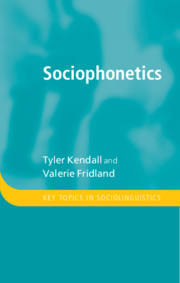Book contents
- Sociophonetics
- Key Topics in Sociolinguistics
- Sociophonetics
- Copyright page
- Contents
- Figures
- Preface
- Acknowledgments
- 1 Sociophonetics = Sociolinguistics + Phonetics
- 2 Sociophonetics and Its Methods
- 3 Sociophonetics and Its Methods
- 4 Sociophonetics and Regional Variation
- 5 Sociophonetics and Social Factors
- 6 Sociophonetics, Style and Identity
- 7 Sociophonetics and Sound Change
- 8 Sociophonetics and Its Methodological Future
- 9 In Closing
- References
- Index
- References
7 - Sociophonetics and Sound Change
Published online by Cambridge University Press: 26 February 2021
- Sociophonetics
- Key Topics in Sociolinguistics
- Sociophonetics
- Copyright page
- Contents
- Figures
- Preface
- Acknowledgments
- 1 Sociophonetics = Sociolinguistics + Phonetics
- 2 Sociophonetics and Its Methods
- 3 Sociophonetics and Its Methods
- 4 Sociophonetics and Regional Variation
- 5 Sociophonetics and Social Factors
- 6 Sociophonetics, Style and Identity
- 7 Sociophonetics and Sound Change
- 8 Sociophonetics and Its Methodological Future
- 9 In Closing
- References
- Index
- References
Summary
Chapter 7 reviews the major theories of sound change that have emerged over the past centuries, honing in on more modern user-based theories most synergistic with sociophonetics.The chapter examines how sociophonetics, and its growth from work in sociolinguistics, has redirected the focus on sound change from a historical and system internal perspective to one forged by and crucially interconnected with the social needs of its users.Along these lines, the discussion emphasizes the empirical approach to the "problems" of sound change articulated in the foundational work by Weinreich, Herzog and Labov in 1968.Turning to recent research that explores these "problems" from a sociophonetic perspective, the treatment suggests that sociophonetics does not just continue a tradition of interest in sound change, it provides new opportunity to understand at a more fine-grained level than ever before the mechanisms underlying language change.
- Type
- Chapter
- Information
- Sociophonetics , pp. 156 - 177Publisher: Cambridge University PressPrint publication year: 2021



